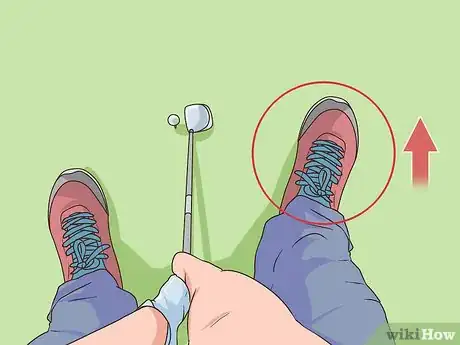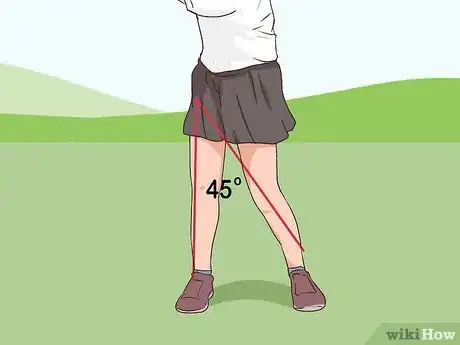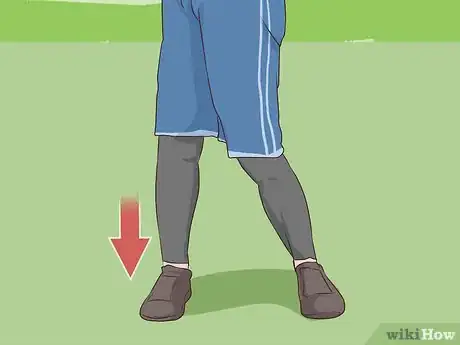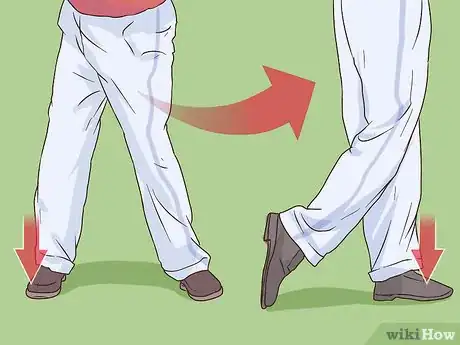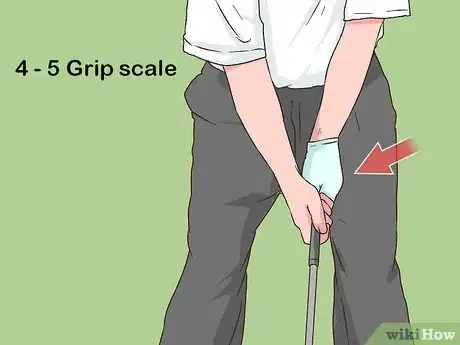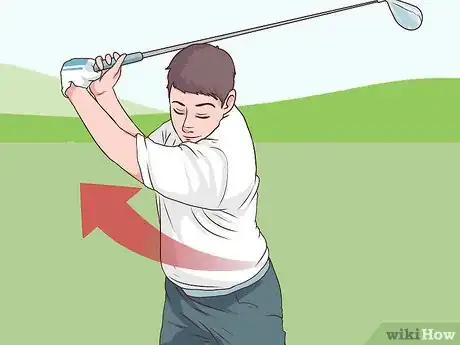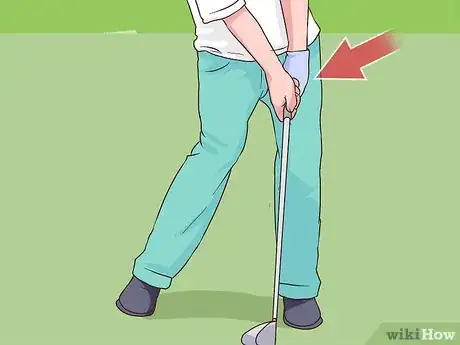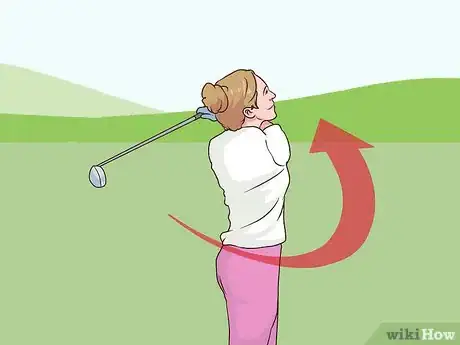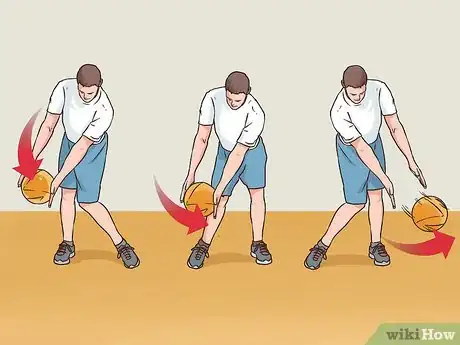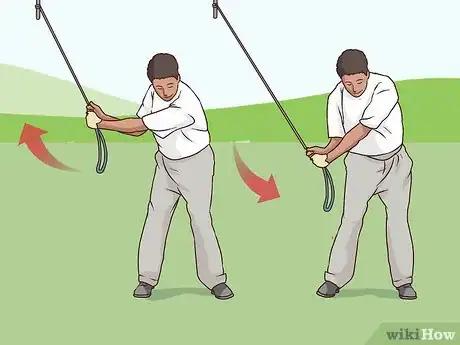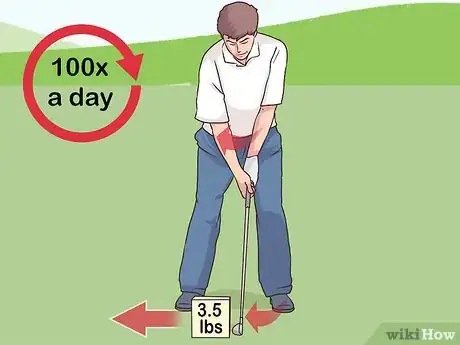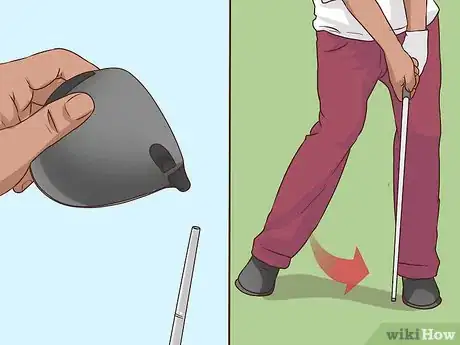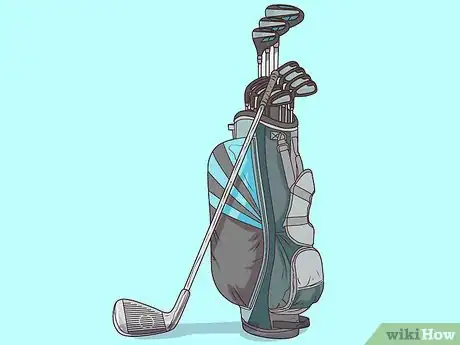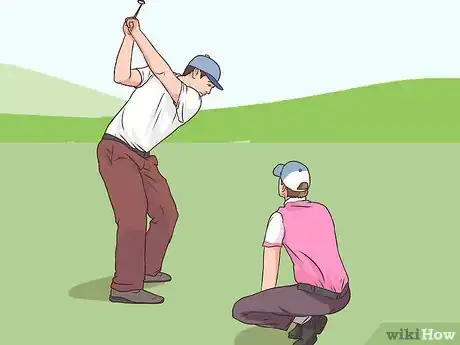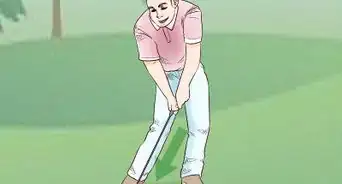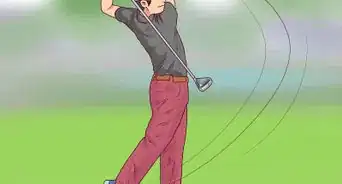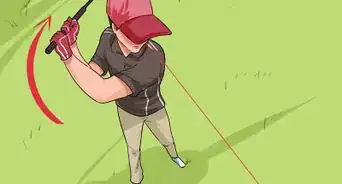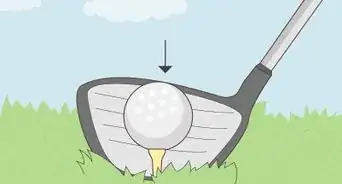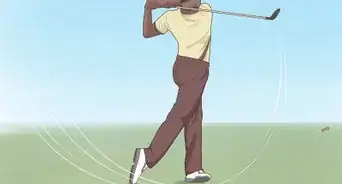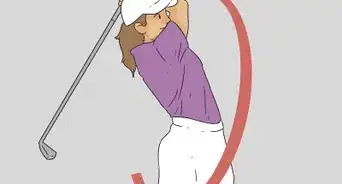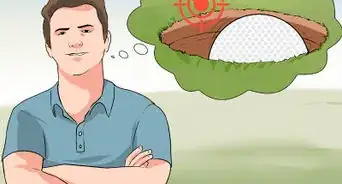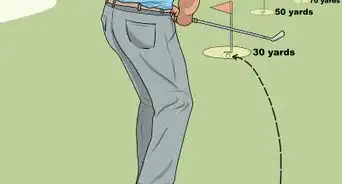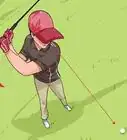This article was co-authored by Michael Metz and by wikiHow staff writer, Sophia Latorre. Michael Metz is a Golf Instructor and the Director of Instruction at Simi Hills Golf Course. With more than 15 years of experience, Michael is adept at coaching all facets of Golf. Mike uses technology, such as Flightscope, V1 Swing Suite, Blast Motion, and BodiTrak pressure mapping, to provide advanced golf training with quick results.
There are 7 references cited in this article, which can be found at the bottom of the page.
This article has been viewed 271,248 times.
If you’re looking to add more power to your golf swing, you can do so by adopting a few simple techniques. Adjust your stance by keeping your weight on the balls of your feet and turning your feet outward. Perfect your swing by keeping a light grip on the club and fully extending your arms after impact. You can also do exercises or drills to generate more power, including throwing a medicine ball to improve your hip rotation. It’s also a great idea to take a few lessons with a golf pro who can give you specific feedback on your stance and swing.
Steps
Adjusting Your Stance
-
1Keep your right foot ahead of your left, if you’re right-handed. Your stance is an important part of your swing. When you are setting up for your swing, make sure to put your right foot a little in front of your left. You can also turn your right foot out a little. Both of these adjustments can help you increase your body coil on the backswing.[1] [2]
- Reverse these instructions if you are a left-handed golfer.
-
2Turn your left foot out 45 degrees. To create a more open stance, turn your left foot out 45 degrees at address. This adjustment may help you uncoil your hips faster, leading to increased power on the downswing. If you are a left-handed golfer, your right foot should be turned out at a 45 degree angle, instead.[3]Advertisement
-
3Brace your right knee. Many right-handed golfers lose power when they sway to the outside of their right foot. You can avoid this by applying pressure with the inside of the right leg to the ground on the backswing. This resistance is released on the downswing, which adds power to your golf game.[4]
- Brace your left knee if you are left-handed.
-
4Keep your weight on the balls of your feet. If you put too much weight on the heels or toes of your feet, you’ll have an unbalanced, and therefore weak, swing. Maintain your balance throughout the swing by keeping your weight on the balls of your feet, which will ensure the most solid strike to the ball.[5]
Perfecting Your Swing
-
1Keep a light grip on the club. Tense muscles in your hands and arms can decrease your swing speed. Relax your grip and arms to avoid this common error. Use an adjustable scale, with 1 being the lightest grip you could have on your club, and 10 being the tightest grip you could have. Aim for a grip of 4 or 5 to provide you with the right amount of control.[6]
-
2Form a wider swing arc. A wider swing arc can give your golf game the power you are looking for. Rather than just picking up the club, extend the club fully away from you on the backswing. Move your arms as far away from your body as possible without moving your head.[7]
-
3Let your feet lead the downswing. On the downswing, plant your left heel and roll both ankles toward the target line. Allowing your feet to lead pulls your knees in the same direction, creating a more powerful hip rotation. This can add power to your swing and help you achieve the handicap you’re looking for.[8]
-
4Unhinge your wrists just before impact. Your wrists will be hinged or cocked on the backswing. Aim to maintain this hinged position of your wrists as long as possible to develop a stronger release. You shouldn’t unlock your wrists on the downswing until just before the club hits the ball.[9]
-
5
Trying Drills and Exercises
-
1Throw a medicine ball. Choose a medicine ball heavy enough to provide resistance when you throw it. Squat with your knees bent a bit further than they would be for your typical golf stance. Hold the medicine ball in both hands directly out in front of yourself. Rotate your hips as hard and fast as you can and release the ball.[12]
- Don’t rotate your shoulders during this exercise.
-
2Exercise with a resistance band. Attach a resistance band to something stable that will not move. Face away from the object anchoring the band and hold the band in your left hand, directly behind you. Get into your usual golf stance. Using an explosive motion, pull the band forward, then let it return to its original position slowly. Repeat using both hands, rather than only your left.[13]
- Stand farther away from what is holding the band to increase the resistance.
-
3Try a woodblock drill. Take your normal golf stance. Place a woodblock, book, or another flat object weighing between 2 and 5 lbs (0.91 and 2.3 kg) directly behind your club. Push the woodblock (or other object) back on the takeaway with the head of your club. This creates extra effort, which adds pressure on your feet.[14]
- Do this drill 100 times per day to increase the power of your golf swing.
-
4Swing a golf club shaft. Remove the head from an old golf club. Take your usual golf stance. Practice swinging the golf club shaft as you normally would. Because the club is lighter without the head, the reaction time of your muscles will increase and you’ll maximize your swing speed at the point of impact.[15]
Setting Yourself Up for Success
-
1Choose the right club for you.[16] The best golf club will depend on the shot as well as your personal style. Generally, woods, including drivers, are used for long-distance shots. Irons are used for shots on the fairway, while wedges are used for shorter approach shots. Putters are used for getting the golf ball into the hole.[17]
-
2Take a golf lesson. You can hit as many balls as you want, but unless you are correcting your technique, your game won’t improve much. Take a golf lesson with a reputable professional who can analyze your stance and swing. You need to receive specific feedback so that you know what to change. They’ll help you make adjustments that will add more power to your golf swing.[18]
-
3Practice deliberately. Once you’ve taken a lesson with a golf pro, you’ll know exactly what you need to work on. Follow this personalized plan to improve the areas that you need to work on. Push yourself just beyond your abilities and keep at it, even if you continually hit bad shots. Focus on improving your technique, and keep trying.[19]
Community Q&A
-
QuestionI have tendency to hit from the top or let my arms dominate the swing. Can you help?
 Community AnswerFocus on having a tighter grip with your left hand, and a softer right hand (if you're a right handed golfer). Also focus on pushing your left arm back, and pulling with the left arm throughout the downswing.
Community AnswerFocus on having a tighter grip with your left hand, and a softer right hand (if you're a right handed golfer). Also focus on pushing your left arm back, and pulling with the left arm throughout the downswing. -
QuestionWhy does the ball always go right on my drive?
 Community AnswerThe direction the ball travels is always the direction the clubhead is facing at impact. If your ball goes to the right, it means the clubhead is open at impact (for a right-handed golfer). Without analyzing your swing, I suggest you hit down on the ball. By concentrating on hitting down on the ball, your clubhead remains square through impact, and the result is a "stinger" type shot that typically goes farther than your normal drive.
Community AnswerThe direction the ball travels is always the direction the clubhead is facing at impact. If your ball goes to the right, it means the clubhead is open at impact (for a right-handed golfer). Without analyzing your swing, I suggest you hit down on the ball. By concentrating on hitting down on the ball, your clubhead remains square through impact, and the result is a "stinger" type shot that typically goes farther than your normal drive. -
QuestionHow do I slow down a swing?
 Community AnswerIt doesn't matter if you're hitting it too far on a 300-yard hole, but if it's a 100-yard hole, you have a problem. Instead of slowing down your swing, use a weekend club to do the job for you.
Community AnswerIt doesn't matter if you're hitting it too far on a 300-yard hole, but if it's a 100-yard hole, you have a problem. Instead of slowing down your swing, use a weekend club to do the job for you.
References
- ↑ Michael Metz. Golf Instructor. Expert Interview. 24 February 2022.
- ↑ http://golftips.golfweek.com/generate-power-golf-swing-20198.html
- ↑ http://golftips.golfweek.com/generate-power-golf-swing-20198.html
- ↑ http://golftips.golfweek.com/generate-power-golf-swing-20198.html
- ↑ http://www.baltimoregolfing.com/content/pro-tips/balance-key-good-golf-swing
- ↑ http://golf-info-guide.com/golf-tips/the-golf-swing/how-to-keep-arms-relaxed-in-the-down-swing-golf-tip/
- ↑ http://golftips.golfweek.com/generate-power-golf-swing-20198.html
- ↑ http://golftips.golfweek.com/generate-power-golf-swing-20198.html
- ↑ http://golftips.golfweek.com/generate-power-golf-swing-20198.html
- ↑ Michael Metz. Golf Instructor. Expert Interview. 24 February 2022.
- ↑ http://golftips.golfweek.com/generate-power-golf-swing-20198.html
- ↑ https://www.americangolf.com/blog/golf-tips/increase-the-power-of-your-golf-swing-with-these-simple-exercises/
- ↑ https://www.americangolf.com/blog/golf-tips/increase-the-power-of-your-golf-swing-with-these-simple-exercises/
- ↑ https://www.americangolf.com/blog/golf-tips/increase-the-power-of-your-golf-swing-with-these-simple-exercises/
- ↑ http://golftips.golfweek.com/generate-power-golf-swing-20198.html
- ↑ Michael Metz. Golf Instructor. Expert Interview. 24 February 2022.
- ↑ https://www.thoughtco.com/meet-the-golf-clubs-1560507
- ↑ http://www.golf.com/instruction/deliberate-practice-key-improving-your-golf-game
- ↑ http://www.golf.com/instruction/deliberate-practice-key-improving-your-golf-game
About This Article
If you want to add more power to your golf swing, stand so your dominant foot is slightly ahead of your non-dominant foot. For instance, if you’re right-handed, place your right foot a little further out than your left foot. Then, turn your non-dominant foot out about 45 degrees, which can increase the power on your downswing. Keep your weight on the balls of your feet, and let your feet lead the downswing by rolling both of your angles toward the target line. Keep reading to learn how to do drills that can improve the power of your swing!
